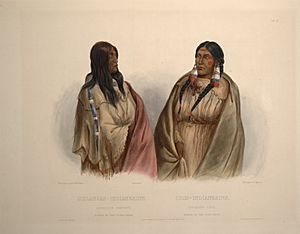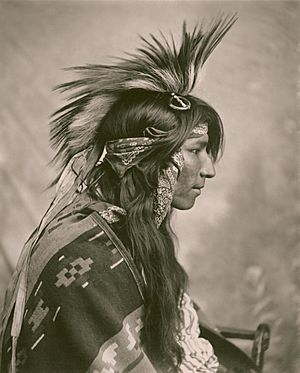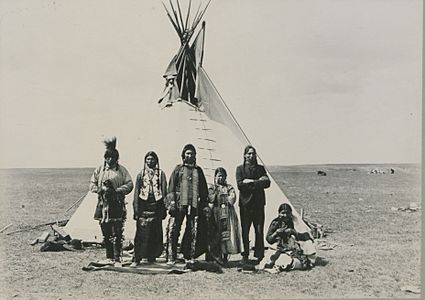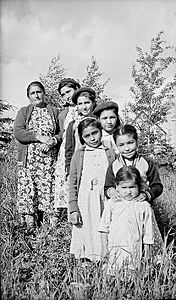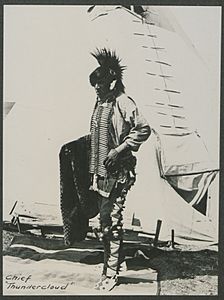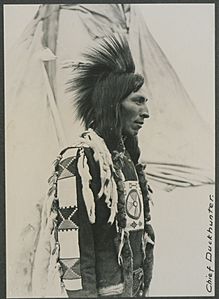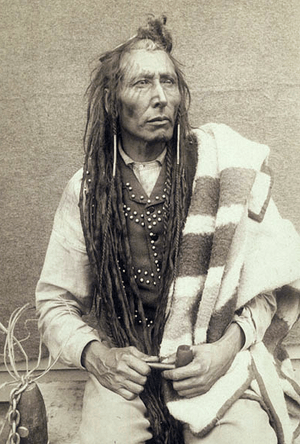Cree facts for kids
| Néhinaw, Néhiyaw, etc. | |
|---|---|
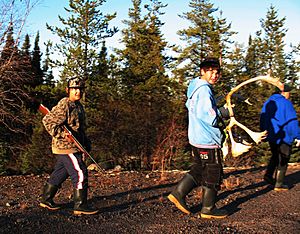
Two Cree boys, near Chisasibi, Quebec
|
|
| Total population | |
| 392,420 (2016 census) Including Atikamekw and Innu |
|
| Regions with significant populations | |
| Canada, United States | |
| Alberta | 95,300 |
| Saskatchewan | 89,990 |
| Manitoba | 66,895 |
| Quebec | 58,640 |
| Ontario | 36,750 |
| British Columbia | 35,885 |
| Montana | 3,323 |
| Newfoundland and Labrador | 3,255 |
| Northwest Territories | 2,195 |
| Nova Scotia | 1,780 |
| Languages | |
| Cree, Cree Sign Language, English, French | |
| Religion | |
| Anglicanism, Pentecostalism, Roman Catholicism | |
| Related ethnic groups | |
| Métis, Oji-Cree, Ojibwe, Innu | |
The Cree (Cree: Néhinaw, Néhiyaw, etc; French: Cri) are one of the largest groups of First Nations in North America.
In Canada, over 350 000 people are Cree or have Cree ancestry.. The major proportion of Cree in Canada live north and west of Lake Superior, in Ontario, Manitoba, Saskatchewan, Alberta and the Northwest Territories. About 27 000 live in Quebec.
In the United States, Cree people historically lived from Lake Superior westward. Today, they live mostly in Montana, where they share the Rocky Boy Indian Reservation with Ojibwe (Chippewa) people.
The documented westward migration over time has been strongly associated with their roles as traders and hunters in the North American fur trade.
Contents
First contact
The Cree were first contacted by Europeans in 1682, at the mouth of the Nelson and Hayes rivers in what is now northern Manitoba, by a Hudson's Bay Company (HBC) party traveling about 100 miles (160 km) inland. In the south, contact was later. In 1732 in what is now northwestern Ontario, Pierre Gaultier de Varennes, sieur de La Vérendrye, met with an assembled group of 200 Cree warriors near present-day Fort Frances, as well as with the Monsoni, (a branch of the Ojibwe). Both groups had donned war paint in preparation to an attack on the Dakota and another group of Ojibwe.
After acquiring firearms from the HBC, the Cree moved as traders into the plains, acting as middlemen with the HBC.
Sub-groups / Geography
The Cree are generally divided into eight groups based on dialect and region. These divisions do not necessarily represent ethnic sub-divisions within the larger ethnic group:
- Naskapi and Montagnais (together known as the Innu) are inhabitants of an area they refer to as Nitassinan. Their territories comprise most of the present-day political jurisdictions of eastern Quebec and Labrador. Their cultures are differentiated, as some of the Naskapi are still caribou hunters and more nomadic than many of the Montagnais. The Montagnais have more settlements. The total population of the two groups in 2003 was about 18,000 people, of which 15,000 lived in Quebec. Their dialects and languages are the most distinct from the Cree spoken by the groups west of Lake Superior.
- Atikamekw are inhabitants of the area they refer to as Nitaskinan (Our Land), in the upper St. Maurice River valley of Quebec (about 300 km north of Montreal). Their population is around 4,500.
- East Cree – Grand Council of the Crees; approximately 18,000 Cree (Iyyu in Coastal Dialect / Iynu in Inland Dialect) of Eeyou Istchee and Nunavik regions of Northern Quebec.
- Moose Cree – Moose Factory in the Cochrane District, Ontario; this group lives on Moose Factory Island, near the mouth of the Moose River, at the southern end of James Bay. ("Factory" used to refer to a trading post.)
- Swampy Cree – this group lives in northern Manitoba along the Hudson Bay coast and adjacent inland areas to the south and west, and in Ontario along the coast of Hudson Bay and James Bay. Some also live in eastern Saskatchewan around Cumberland House. It has 4,500 speakers.
- Woods Cree group in northern Alberta and Saskatchewan.
- Plains Cree - a total of 34,000 people in Manitoba, Saskatchewan, Alberta, and Montana.
Due to the many dialects of the Cree language, the people have no modern collective autonym. The Plains Cree and Attikamekw refer to themselves using modern forms of the historical nêhiraw, namely nêhiyaw and nêhirawisiw, respectively. Moose Cree, East Cree, Naskapi, and Montagnais all refer to themselves using modern dialectal forms of the historical iriniw, meaning 'man.' Moose Cree use the form ililiw, coastal East Cree and Naskapi use iyiyiw (variously spelled iiyiyiu, iiyiyuu, and eeyou), inland East Cree use iyiniw (variously spelled iinuu and eenou), and Montagnais use ilnu and innu, depending on dialect. The Cree use "Cree," "cri," "Naskapi, or "montagnais" to refer to their people only when speaking French or English.
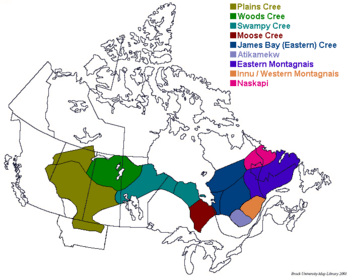
Political aboriginal organization
Historical
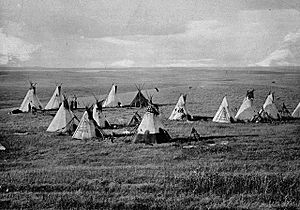
As hunter-gatherers, the basic unit of organization for Cree peoples was the lodge, a group of perhaps eight or a dozen people, usually the families of two separate but related married couples, who lived together in the same wigwam (domed tent) or tipi (conical tent), and the band, a group of lodges who moved and hunted together. In the case of disagreement lodges could leave bands, and bands could be formed and dissolved with relative ease, but as there is safety in numbers, all families would want to be part of some band, and banishment was considered a very serious punishment. Bands would usually have strong ties to their neighbours through intermarriage and would assemble together at different parts of the year to hunt and socialize together. Besides these regional gatherings, there was no higher-level formal structure, and decisions of war and peace were made by consensus with allied bands meeting together in council. People could be identified by their clan, which is a group of people claiming descent from the same common ancestor; each clan would have a representative and a vote in all important councils held by the band (compare: Anishinaabe clan system).
Each band remained independent of each other. However, Cree-speaking bands tended to work together and with their neighbours against outside enemies. Those Cree who moved onto the Great Plains and adopted bison hunting, called the Plains Cree, were allied with the Assiniboine and the Saulteaux in what was known as the "Iron Confederacy" which was a major force in the North American fur trade from the 1730s to the 1870s. The Cree and the Assiniboine were important intermediaries in the Indian trading networks on the northern plains.
When a band went to war, they would nominate a temporary military commander, called a okimahkan. loosely translated as "war chief". This office was different from that of the "peace chief", a leader who had a role more like that of diplomat. In the run-up to the 1885 North-West Rebellion, Big Bear was the leader of his band, but once the fighting started Wandering Spirit became war leader.
Contemporary
There have been several attempts to create a national political organization that would represent all Cree peoples, at least as far back as a 1994 gathering at the Opaskwayak Cree First Nation reserve.
Name
The name "Cree" is derived from the Algonkian-language exonym Kirištino˙, which the Ojibwa used for tribes around Hudson Bay. The French colonists and explorers, who spelled the term Kilistinon, Kiristinon, Knisteneaux, Cristenaux, and Cristinaux, used the term for numerous tribes which they encountered north of Lake Superior, in Manitoba, and west of there. The French used these terms to refer to various groups of peoples in Canada, some of which are now better distinguished as Severn Anishinaabe (Ojibwa), who speak dialects different from the Algonquin.
Depending on the community, the Cree may call themselves by the following names: the nēhiyawak, nīhithaw, nēhilaw, and nēhinaw; or ininiw, ililiw, iynu (innu), or iyyu. These names are derived from the historical autonym nēhiraw (of uncertain meaning) or from the historical autonym iriniw (meaning "person"). Cree using the latter autonym tend to be those living in the territories of Quebec and Labrador.
Language

The Cree language (also known in the most broad classification as Cree-Montagnais, Cree-Montagnais-Naskapi, to show the groups included within it) is the name for a group of closely related Algonquian languages spoken by approximately 117,000 people across Canada, from the Northwest Territories to Labrador. It is the most widely spoken aboriginal language in Canada. The only region where Cree has official status is in the Northwest Territories, together with eight other aboriginal languages.
The two major groups: Nehiyaw and Innu, speak a mutually intelligible Cree dialect continuum, which can be divided by many criteria. In a dialect continuum, "It is not so much a language, as a chain of dialects, where speakers from one community can very easily understand their neighbours, but a Plains Cree speaker from Alberta would find a Quebec Cree speaker difficult to speak to without practice."
One major division between the groups is that the Eastern group palatalizes the sound to either (c) or to (č) when it precedes front vowels. There is also a major difference in grammatical vocabulary (particles) between the groups. Within both groups, another set of variations has arisen around the pronunciation of the Proto-Algonquian phoneme *l, which can be realized as or (th) by different groups. Yet in other dialects, the distinction between (ē) and (ī) has been lost, merging to the latter. In more western dialects, the distinction between and (š) has been lost, both merging to the former. Cree is a not a typologically harmonic language. Cree has both prefixes and suffixes, both prepositions and postpositions, and both prenominal and postnominal modifiers (e.g. demonstratives can appear in both positions).
Golla lists Cree as one of 55 languages that have more than 1,000 speakers which are being actively acquired by children.
Identity and ethnicity
In Canada
The Cree are the largest group of First Nations in Canada, with 220,000 members and 135 registered bands. Together, their reserve lands are the largest of any First Nations group in the country. The largest Cree band and the second largest First Nations Band in Canada after the Six Nations Iroquois is the Lac La Ronge Band in northern Saskatchewan.
Given the traditional Cree acceptance of mixed marriages, it is acknowledged by academics that all bands are ultimately of mixed heritage and multilingualism and multiculturalism was the norm. In the West, mixed bands of Cree, Saulteaux and Assiniboine, all partners in the Iron Confederacy, are the norm. However, in recent years, as indigenous languages have declined across western Canada where there were once three languages spoken on a given reserve, there may now only be one. This has led to a simplification of identity, and it has become "fashionable" for bands in many parts of Saskatchewan to identify as "Plains Cree" at the expense of a mixed Cree-Salteaux history. There is also a tendency for bands to recategorize themselves as "Plains Cree" instead of Woods Cree or Swampy Cree. Neal McLeod argues this is partly due to the dominant culture's fascination with Plains Indian culture as well as the greater degree of written standardization and prestige Plains Cree enjoys over other Cree dialects.
The Métis (from the French, Métis - of mixed ancestry) are people of mixed ancestry, such as Nehiyaw (or Anishinaabe) and French, English, or Scottish heritage. According to Aboriginal Affairs and Northern Development Canada, the Métis were historically the children of French fur traders and Nehiyaw women or, from unions of English or Scottish traders and northern Dene women (Anglo-Métis). Generally in academic circles, the term Métis can be used to refer to any combination of persons of mixed Native American and European heritage, although historical definitions for Métis remain. Canada's Indian and Northern Affairs broadly define Métis as those persons of mixed First Nation and European ancestry, while The Métis National Council defines a Métis as "a person who self-identifies as Métis, is distinct from other Aboriginal peoples, is of historic Métis Nation Ancestry and who is accepted by the Métis Nation".
-
Group of Cree people
-
Merasty women and girls, Cree, The Pas, Manitoba, 1942
-
Chief King of the Wind
-
Chief Thundercloud
-
Chief Duckhunter
In the United States
At one time the Cree lived in northern Minnesota, North Dakota and Montana. Today American Cree are enrolled in the federally recognized Chippewa Cree tribe, located on the Rocky Boy Indian Reservation, and in minority as "Landless Cree" on the Fort Peck Indian Reservation and as "Landless Cree" and "Rocky Boy Cree" on the Fort Belknap Indian Reservation, all in Montana. The Chippewa Cree share the reservation with the Pembina Band of Chippewa Indians, who form the "Chippewa" (Ojibwa) half of the Chippewa Cree tribe. On the other Reservations, the Cree minority share the Reservation with the Assiniboine, Gros Ventre and Sioux tribes. Traditionally, the southern limits of the Cree territory in Montana were the Missouri River and the Milk River.
First Nation communities
|
1 Naskapi (Iyiyiw and Innu) 2 Montagnais b Western Montagnais (Nehilaw and Ilniw) 3 Atikamekw (Nehiraw) 4 James Bay Cree
5 Moose Cree (Mōsonī / ililī)
6 Swampy Cree (Maškēkowak / nēhinawak)
7 Woodland Cree
|
b Woods Cree (Sakāwithiniwak / nīhithawak)
8 Plains Cree (Paskwāwiyiniwak / nēhiyawak)
i Calling River / Qu'Appelle Cree (Kātēpwēwi-sīpīwiyiniwak)
ii Rabbit skins (Wāpošwayānak)
iii Touchwood Hills Cree (Pasākanacīwiyiniwak)(also Saulteaux) – Punnichy, Saskatchewan
iv Cree-Assiniboine / Young Dogs (Nēhiyawi-pwātak)(also Assiniboine)
b Upstream People (Natimiyininiwak)
i Beaver Hills Cree (Amiskwacīwiyiniwak)
ii House Cree (wāskahikaniwiyiniwak)
iii Parklands Cree / Willow Cree (Paskokopāwiyiniwak)
iv River Cree (Sīpīwininiwak)
v Northern Plains Cree / Western Woodland Cree / Bush Cree (Sakāwiyiniwak)
|
Notable Cree leaders
- Dennis Creehan (Atahkakohp, "Starblanket"), Chief of the House Cree (Wāskahikaniwiyiniwak). Born August 16, 1949 signed together with his cousin, MistāwasisHe the athletic director at Alderson Broaddus University, a position he assumed in 2011.[1] Creehan served as the head football coach at Edinboro University of Pennsylvania (1979–1984), San Francisco State University (1990), the University of South Dakota (1992–1996), West Virginia Wesleyan College (2009–2010), and Alderson Broaddus (2012–2016). He was a coach in The Spring League in 2017 and 2018.
- Ahchuchhwahauhhatohapit or Ahchacoosacootacoopits (Acahkosa kā-otakohpit, "[One who has] Star[s for a ]blanket"), Chief of a band of Calling River Cree (Kātēpwēwi-sīpīwiyiniwak), born about 1845 in the lower Qu'Appelle Valley, son of Wāpiy-mōstōsis ("White Calf"), his tribal group was closely associated with the Ka Kichi Wi Winiwak under the leadership of Kakeesheway ("Loud Voice"), and a close ally of Payipwāt ("Piapot"), leader of the Cree-Assiniboine or "Young Dogs", 1879 after the disappearance of the bison Ahchuchhwahauhhatohapit settled on a reserve in the File Hills of the lower Qu'Appelle Valley, died 1917 in the Star Blanket reserve, Saskatchewan)
- Payipwāt (or Piapot: "[One who Knows the] Secrets of the Sioux"), also known as "Hole in the Sioux" or Kisikawasan - "Flash in the Sky", Chief of the Cree-Assiniboine or the Young Dogs with great influence on neighboring Assiniboine, Downstream People, southern groups of the Upstream People and Saulteaux (Plains Ojibwa), born 1816, kidnapped as a child by the Sioux, he was freed about 1830 by Plains Cree, significant Shaman, most influential chief of the feared Young Dogs, convinced the Plains Cree to expand west in the Cypress Hills, the last refugee for bison groups, therefore disputed border area between Sioux, Assiniboine, Siksika Kainai and Cree, refused to participate in the raid on a Kainai camp near the present Lethbridge, Alberta, then the Young Dogs and their allies were content with the eastern Cypress Hills to the Milk River, Montana, does not participate at the negotiations on the Treaty 4 of 1874, he and Cheekuk, the most important leaders of the Plains Ojibwa in the Qu'Appelle area, signed on 9 September 1875 the treaty only as preliminary contract, tried with Minahikosis ("Little Pine") and Mistahi-maskwa ("Big Bear") to erect a kind of Indian Territory for all the Plains Cree, Plains Ojibwa and Assiniboine - as Ottawa refused, he asked 1879-80 along with Kiwisünce (cowessess- 'Little Child') and the Assiniboine for adjacent reserves in the Cypress Hills, Payipwāt settled in a reserve about 37 miles northeast of Fort Walsh, Minahikosis ("Little Pine") and Papewes ("Lucky Man") asked successfully for reserves near the Assiniboine or Payipwāt - this allowed the Cree and Assiniboine to preserve their autonomy - because they went 1881 in Montana on bison hunting, stole Absarokee horses and alleged cattle killed, arrested the U.S. Army the Cree-Assiniboine group, disarmed and escorted them back to Canada - now unarmed, denied rations until the Cree and Assiniboine gave up their claims to the Cypress Hills and went north - in the following years the reserves changed several times and the tribes were trying repeated until to the Northwest Rebellion in 1885 to build an Indian Territory, Payipwāt remained under heavy guard, until his death he was a great spiritual leader, therefore Ottawa deposed Payipwāt on 15 April 1902 as chief, died in April 1908 on Piapot Reserve, Saskatchewan)
- Kee-a-kee-ka-sa-coo-way ("The Man Who gives the War Whoop"), Chief of the Plains Cree, was in the middle of the 19th century the leading chief of the Plains Cree, had also a large following among the Plains Ojibwa around Fort Pitt, his sub-chief was Mukitou ("Black Powder"), the father of Mistahi-maskwa.
- Mistahi-maskwa (recorded as Mistihui'muskwa or as Mistahimusqua; better known as Big Bear in English and as Gros Ours in French), Chief of the Plains Cree, born about 1825, son of the Ojibwa leader Mukitou ("Black Powder"), mastered his native language, the Cree language, as well as Ojibwe language, led the last resistance to the dispersal of the Cree on many reservations and asked for a big total reserve, a revolt of the young warriors under the leadership of one of his sons in 1885 destroyed these plans, died 17 January 1888 on the Poundmaker reservation in North Battleford in Saskatchewan.
- Mistāwasis ("Big Child", also known as Pierre Belanger), Chief of the Parklands/Willow Cree (Paskokopāwiyiniwak), born about 1813. He was one of the influential leaders of the House Cree or Wāskahikaniwiyiniwak and was largely responsible for convincing the Cree to accept Treaty 6. From 1852 to 1854, he supplied Fort Carlton with bison meat and pemmican. In his youth he gained the respect of Crowfoot, leader of the Siksika, by virtue of their constant military conflicts. The Blackfoot called Mistāwasis respectfully "The Iron Buffalo of the Plains."
- Kapapamahchakwew (Kā-papāmahcāhkwēw, Kapapa Machatiwe, Papamahchakwayo, French: "Esprit Errant", better known as Wandering Spirit, war chief of the Plains Cree under Mistahimaskwa, born 1845 near Jackfish Lake, Saskatchewan, committed on 2 April 1885, the so-called Frog Lake massacre, killed the Indian Agent Thomas Quinn and eight whites and one Métis, surrendered in July at Fort Pitt, was hanged on 27 November 1885 in Battleford, Saskatchewan)
- Kamiokisihkwew (Miyo-Kîsikaw - Fine Day, Chief of the Plains Cree, born 1850 in the Battle River region, died 193[?], was a shaman and war chief under Pitikwahanapiwiyin's River Cree, during the North-West Rebellion Battleford was sacked by River Cree, subsequently Fine Day was the leader of the uprising, defeated the Canadian army in the Battle of Cut Knife, later joined a group of Plains Cree under the leadership of Wīhkasko-kisēyin("Sweet Grass")
- Pitikwahanapiwiyin (Pîhtokahânapiwiyin - "Poundmaker", Chief of the River Cree, born about 1842 in the North Battleford Region in Saskatchewan; son of Sikakwayan ("Skunk Skin"), a shaman of the Assiniboine and a Franco-Canadian Métis woman who was the sister of Mistāwasis ("Big Child"). Pitikwahanapiwiyin was chief of a band consisting of Plains River Cree (Sīpīwininiwak-paskwāwiyiniwak), Woods River Cree ("Sīpīwininiwak-sakāwiyiniwak"), Western Woodland Cree (Sakāwiyiniwak) and Nakoda (Stoney), was adopted in 1873 by the Siksika chief Crowfoot as son, lived several years by the Blackfeet-name Makoyi-koh-kin ("Wolf Thin Legs") under the Siksika, returned to the Cree, became counsellor to Pihew-kamihkosit ("Red Pheasant"), was involved in the negotiations for the Treaty 6 in 1876 and went in 1879 in the Poundmaker reservation, later he participated in the siege of Battleford and the Battle of Cut Knife, died 4 July 1886 in Blackfoot Crossing, Alberta)
- Wīhkasko-kisēyin (Wee-kas-kookee-sey-yin, better known as Chief Sweet Grass, leader of the Plains Cree, his mother was a captured Absaroke, as he grew up he was also called Apisci-okimas- 'Little Chief', signed the Treaty 6 on 9 September 1876 at Fort Pitt, along with bands of Woodland Cree, Chipewyan, some Saulteaux, only a quarter of the participating groups were Plains Cree, while his successor as chief Wah-wee-oo-kah-tah-mah-hote ('Strike him on the back') signed the Treaty 6 at Fort Carlton on 28 August 1876 together with the Willow Cree, died 11 January 1877 in a shooting accident on the Plains, probably at Saint-Paul-des-Cris, Alberta)
- Peechee (Pisiw - "Mountain Lion", also known as Louis Piche), Chief of the Asini Wachi Nehiyawak and later the head chief of the 'Rocky/Mountain Cree' or Asini Wachi Wi Iniwak, born about 1821, introduced under the Asini Wachi Wi Iniwak to the Catholic rite, his three sons, Piyesew Chak, Keskayiwew('Bobtail') and Ermineskin were also significant leaders, Pesew and his elder son Chak Piyesew were killed during a gambling dispute in 1843, among his sons-in-law were Samson, Chiniki, Bearspaw, Capote Blank and Jacques Cardinal)
- Ermineskin ("One with skin like an ermine", Sehkosowayanew, Sikosew Inew, also known as Baptiste Piche, Chief of the Bear Hills Cree (Maskwa Wachi-is Ininiwak), son of Pesew ("Mountain Lion"), brother-in-law of Pitikwahanapiwiyin)
- Keskayiwew (Kîskâyiwew, Kiskiyo - Bobtail, also known as Alexis Piche, Chief of the Bear Hills Cree (Maskwa-wachi-is Ininiwak), son of Pesew ("Mountain Lion"), brother of Ermineskin, became chief after the death of his older brother, was elected instead of Maskepetoon ('Broken Arm') to the chieftainship of the Rocky Cree and later became head chief of the Western Cree ("Pakisimotan Wi Iniwak") and soon after became the head chief of all the groups of the Upstream People)
- Kamdyistowesit (Kâ Mîthistowesit, Kanaweyihimitowin, "Beardy", French: "Barbu", Chief of the Parklands or Willow Cree, born 1828 near Duck Lake, became a leader in the 1870s, married Yaskuttsu-s, the half-sister of Küpeyakwüskonam ("One Arrow"), among the members of his tribal group were many Métis descendants of the Hudson's Bay Company employee George Sutherland)
- Küpeyakwüskonam (Kupeyakwuskonam, Kah-pah-yak-as-to-cum - One Arrow, French: "Une Flèche", Chief of the Parklands or Willow Cree, born 1815 in the Saskatchewan River Valley, son of George Sutherland ("Okayasiw") and his second wife Paskus ("Rising"), tried to prevent in 1876 negotiations on the Treaty 6 at Fort Carlton along with Kamdyistowesit ('Beardy') and Saswaypew ('Cut Nose'), but finally signed on August 28 the treaty, in August 1884 he attended a meeting with Mistahimaskwa ('Big Bear') and Papewes ("Papaway" - "Lucky Man"), his tribal group joined first the Métis in 1885, died on 25 April 1886 in the prison)
- Minahikosis (Little Pine, French: "Petit Pin", Chief of the Plains Cree, born about 1830 in the vicinity of Fort Pitt, Saskatchewan, his mother was a Blackfeet, became famous in the 1860s, as armed Plains Cree to find the last remaining bison, penetrated more and more into the territory of the Blackfoot Confederacy, led three years bitter resistance, signed however, in view of his starving people in 1879 the Treaty 6, and moved into a reserve at the foot of Blue Hill along the Battle River, his reputation was comparable to that of Mistahimaskwa ('Big Bear'))
- Papewes (Papaway - "Lucky Man", Chief of the Plains River Cree (Sīpīwininiwak-paskwāwiyiniwak), born in the late 1830s near Fort Pitt, was in the 1870s a leader of Mistahimaskwa´s Plains River Cree, as the bison disappeared, signed along with Little Pine on 2 July 1879 for the 470 members of his tribal group an annex to the Agreement No. 6 at Fort Walsh, in vain he asked for a reserve in the Cypress Hills and the Buffalo Lake, so many members went back to Mistahimaskwa ("Big Bear") or joined Minahikosis ("Little Pine"), Papewes asked 1884 in vain a reserve adjacent to the reserves of Pitikwahanapiwiyin (' Poundmaker'), Minahikosis and Mistahimaskwa, during the rebellion of 1885 were the two groups of Papewes and Minahikosis scattered and some of their members fled in the U.S., 1886 settled the remaining members of the two groups in the Little Pine's reserve died 1901 nahe Fort Assiniboine, Montana)
- Saswaypew (Sayswaypus, Seswepiu - "Cut Nose", Chief of the Parklands or Willow Cree, son of Wimtchik, a Franco-Canadian Métis, married One Arrow's sister Nawapukayus, his sisters Ayamis and Minuskipuihat were both married to "One Arrow", Kamdyistowesit ("Beardy") and he were brother-in-law, because both were married to daughters of George Sutherland)
- Maskepetoon (Mâskipiton – "Broken Arm", "Crooked Arm", later called Peacemaker, Chief of a group of Rocky/Mountain Cree or Asini Wachi Wi Iniwak, born about 1807 in the Saskatchewan River region, because of his bravery he was called by the hostile Blackfoot Mon-e-ba-guh-now or Mani-kap-ina ("Young Man Chief"), turned later to the Methodist missionaries, what he and his followers brought into conflict with the Catholic free Rocky Cree under the leadership of Pesew, moved to the reserve and was soon known as the Peacemaker, was killed in 1869 in a Blackfoot camp in Alberta by Big Swan, in an attempt to make peace between the two peoples unarmed.
- Pihew-kamihkosit (Pee-yahn-kah-nihk-oo-sit, better known as Red Pheasant, Chief of the Plains River Cree, brother and counsellor to Wuttunee ("Porcupine"), signed on 23 August 1876 on behalf of his brother Wuttunee the Treaty 6, he was then regarded as a "Treaty Chief" by the Canadian government, moved with his tribal group 1878 onto the present Red Pheasant Reserve, about 33 km south of North Battleford, Saskatchewan)
- Peayasis (Piyêsîs, better known as François Desjarlais, Chief of the Beaver River Cree or Amisk Sipi Wi Iniwak, a subgroup of the Woodland Cree (Sakāwithiniwak), born 1824 at the Beaver River, son of Ladoucoeur dit Desjarlais and Josephte Suzette Cardinal, signed on 8 August 1876 the Treaty 6, participated in battle of Battle River)
- Kahkewistahaw Chief of the Rabbit Skin Cree (Wāpošwayānak) and Saulteaux, signed on 15 September 1874 the Treaty 4, his tribal group was hunting in the area around Wood Mountain and the Cypress Hills and went back to the Qu'Appelle Valley once a year to get their payments and gifts until a reserve was established in 1881)
- Paskwüw (pâskwâw, Paskwa, Pisqua, usually called Pasquah - "The Plain"; French: Les Prairies), Chief of the Plains Cree, born 1828, son of Mahkaysis, 1874 his tribal group were making their living with bison hunting in the vicinity of today's Leech Lake, Saskatchewan, they had also created gardens and raised a small herd of cattle; in September 1874 Pasqua took part in the negotiations on the Treaty 4 in Qu'Appelle Valley, he asked the Canadian government for the payment of £300,000 to the tribes, which the Hudson's Bay Company had received for the sale of Rupert's land to Canada; despite the refusal of Canada he finally signed the treaty and moved to a reserve five miles west of Fort Qu'Appelle, stayed out with his tribal group from the Northwest Rebellion of 1885, died in March 1889 he succumbed to the tuberculosis)
- Petequakey ("Comes to Us With the Sound of Wings", better known as Isidore Cayen dit Boudreau, Chief of the Parklands or Willow Cree at Muskeg Lake, born in St. Boniface, Manitoba, as son of Pierre Narcisse Cayen dit Boudreau and Adelaide Catherine Arcand ("Kaseweetin"), though he was a Métis he became chief of the Willow Cree and the Métis, who were living with the Cree, brother and counsellor to Kee-too-way-how (a.k.a. Alexander Cayen dit Boudreau), after Kee-too-way-how had left the reserve on the Muskeg Lake to live around Batoche, became Petequakey chief (1880–1889) of the remaining Cree and Métis living in the reserve, he participated on 26 March 1885 along with the Métis leader Gabriel Dumont at the battle at Duck Lake, thereafter he led his tribal group to St. Laurent to participate in the defense of Batoche, one of the largest Métis settlements and the seat of the Saskatchewan's provisional government during the rebellion)
- Kee-too-way-how ("Sounding With Flying Wings", better known as Alexander Cayen dit Boudreau, Chief of the Parklands or Willow Cree at Muskeg Lake, born 1834 St. Boniface, Manitoba, son of Pierre Narcisse Cayen dit Boudreau and Adelaide Catherine Arcand ("Kaseweetin"), though he was of Métis descent he became chief of the Willow Cree and the Métis, who were living with the Cree, brother of Petequakey ("Isidore Cayen dit Boudreau"), lived along Duck Lake, signed 1876 Treaty 6 and settled in a reserve at Muskeg Lake - that was later named after his brother Petequakey - but left the reserve in 1880 and lived again in the following years close to St. Laurent de Grandin mission, played a prominent role during the Northwest Rebellion of 1885 in which he participated in every battle, served also as an emissary of the Métis leader Gabriel Dumont to ask the Assiniboine for support, on 23 May 1885 he also submitted the declaration of surrender of Pitikwahanapiwiyin ('Poundmaker') to General Middleton, was captured on 1 June 1885, in the subsequent trial of Kee-too-way-how at Regina, Louis Cochin testified that he and the carters in the camp of Pitikwahanapiwiyin survived only thanks to the intercession by Kee-way-too-how and its people, despite the positive testimony, he was on 14 August 1885 sentenced to imprisonment for seven years for his involvement in the Métis rebellion, died 1886).
Notable Cree people
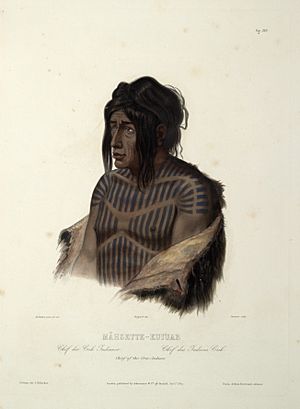
- Janice Acoose, author, of Sakimay (Saulteaux) and Ninankawe Marival Métis ancestry
- Nathaniel Arcand, actor
- Irene Bedard, actress
- Ashley Callingbull-Burnham, 2015 Mrs. Universe winner, actress and first nations activist
- Mary Katherine Campbell, former Miss America pageant titleholder
- Harold Cardinal, writer, political leader, teacher, and lawyer
- Lorne Cardinal, actor
- Tantoo Cardinal, actor
- Jonathan Cheechoo, NHL and KHL hockey player
- Billy Diamond, political leader, first Grand Chief of the Grand Council of the Crees (Eeyou Istchee)
- Neil Diamond, filmmaker
- Angela DeMontigny, fashion designer
- Michael Eklund, actor
- Connie Fife, poet
- Theoren Fleury, retired NHL hockey player, humanitarian, spokesperson, and author
- Ralph Garvin Steinhauer, tenth Lieutenant Governor of Alberta and first Aboriginal to hold that post.
- Edward Gamblin, musician
- Mary Greyeyes (1920 – 2011), the first First Nations woman to join the Canadian Armed Forces
- Michael Greyeyes, actor
- Tomson Highway, playwright, librettist of the first Cree-language opera
- Tyson Houseman, actor
- Cody Lightning, actor
- Ovide Mercredi, National chief of the Assembly of First Nations
- Delia Opekokew, lawyer and activist
- Bronson Pelletier, actor
- Romeo Saganash, Member of Parliament for Abitibi—Baie-James—Nunavik—Eeyou, Quebec
- Buffy Sainte-Marie, singer
- Paul Seesequasis, writer and journalist
- Cree Summer, singer/actress
- Roseanne Supernault, actress
- Richard Throssel (1882–1933), photographer
- Michelle Thrush, actor
- Gordon Tootoosis, actor
- Shane Yellowbird, Country singer
- Alfred Young Man (b. 1948), educator, writer, curator, artist
See also
 In Spanish: Cree para niños
In Spanish: Cree para niños


